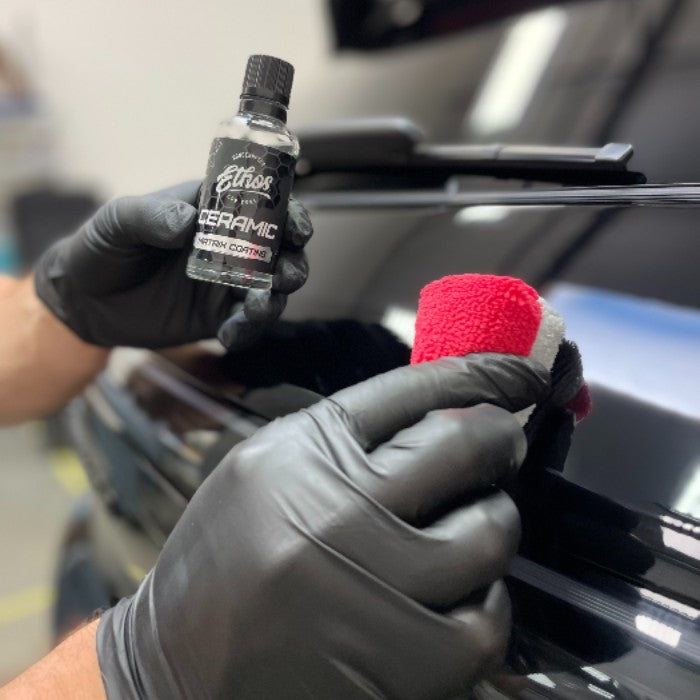How to identify a quality Ceramic Coating Newark job
Discovering the Science Behind Car Ceramic Coating and Its Protective Qualities
The scientific research of car ceramic coating presents a remarkable research in advanced automobile security. Composed mainly of silicon dioxide and polymers, these coatings develop a durable bond with automobile paint. This interaction boosts longevity against ecological threats while offering hydrophobic benefits. However, the complexities of just how these coverings work and their long-term advantages continue to be much less recognized. Unpacking these information reveals why ceramic finishes are coming to be a preferred choice for vehicle treatment
What Is Ceramic Coating?
Ceramic coating is a fluid polymer that chemically bonds to the surface area of a lorry's paint. This innovative safety layer boosts toughness and supplies superior resistance to ecological variables. Unlike conventional wax or sealants, which offer temporary defense, ceramic layers develop a durable guard that can endure harsh problems such as UV rays, acidic pollutants, and extreme climate. When used properly, the coating creates a hydrophobic surface area, causing water to grain and slide off, which assists in keeping the vehicle's tidiness. Additionally, it supplies enhanced gloss and deepness to the paint, making the vehicle appear even more sleek and vibrant. The application procedure typically involves extensive surface area prep work, including cleaning and polishing, to ensure peak bonding. Because of this, ceramic finishings are coming to be significantly preferred amongst car enthusiasts and those looking for to protect their financial investments, assuring to preserve the lorry's visual allure while decreasing the regularity of maintenance.
The Structure of Ceramic Coatings
The intricate formulation of ceramic layers mainly includes silicon dioxide (SiO2), which is acquired from all-natural resources like quartz and sand. This key part gives the structure for the coating's longevity and safety top qualities. Along with SiO2, ceramic coatings often consist of different polymers and additives that enhance bond, flexibility, and resistance to environmental variables. These substances function synergistically to develop a durable barrier versus pollutants such as dirt, chemicals, and UV rays.Furthermore, some solutions incorporate titanium dioxide (TiO2) or other nanomaterials, which can augment the coating's hydrophobic homes, causing improved water repellency. The exact structure can differ substantially amongst manufacturers, affecting performance and longevity. Eventually, the mix of these aspects culminates in a safety layer that not just improves the aesthetic allure of vehicles however additionally offers to lengthen their life expectancy by protecting the surface from possible damage.
Exactly How Ceramic Coatings Work
Recognizing exactly how ceramic finishes work entails exploring their chemical composition, which adds to their protective qualities. The application procedure is crucial for accomplishing excellent outcomes, while durability and toughness variables identify the coating's efficiency over time. Together, these elements highlight the advantages and performance of ceramic finishings for automobile defense.
Chemical Structure Explained
While many car proprietors seek lasting defense for their lorries, the chemical structure of ceramic finishings plays an important function in their performance. These finishes largely include silicon dioxide (SiO2), which is stemmed from natural minerals. This substance develops a strong bond with the vehicle's paint, producing a long lasting, protective layer. In addition, numerous ceramic coverings consist of titanium dioxide (TiO2), enhancing their hydrophobic homes and resistance to UV rays. The existence of polysiloxanes can better enhance versatility and sturdiness. Together, these components add to the coating's ability to repel water, dirt, and contaminants, while likewise supplying a high-gloss surface. Comprehending this chemical structure helps car owners value the robust defense supplied by ceramic finishes.
Application Process Review
Applying ceramic finishings entails a precise procedure that assures excellent bonding and security for the car's surface. At first, detailed cleaning and decontamination of the car's exterior are done to get rid of dust, gunk, and previous waxes. This step validates that the surface is devoid of contaminations that can impede bond. Following this, the paint is often polished to enhance quality and eliminate any flaws. As soon as prepared, the ceramic coating is used in little areas making use of an applicator pad, enabling consistent protection. The coating is after that left to treat, forming a strong chemical bond with the surface area. Proper curing times and conditions are critical, as they confirm the coating achieves address its optimum efficiency and protective top qualities.
Durability and Toughness Factors
Ceramic finishes are developed to provide durable protection via their sophisticated chemical make-up, which creates a robust barrier versus ecological pollutants. The durability of these finishings is affected by variables such as the density of the application, the quality of the item, and the problems under which the car is subjected. Premium ceramic coverings can last a number of years, withstanding scrapes, UV rays, and chemical stains. Proper maintenance, including routine cleaning and periodic reapplication, can even more boost durability. Furthermore, ecological elements like climate and exposure to pollutants can impact the lifespan of the coating. Overall, when applied and maintained properly, ceramic coverings provide phenomenal toughness, making them a preferred selection for car enthusiasts looking for to protect their lorry's look.
Hydrophobic Characteristics and Water Repellency
Hydrophobic residential or commercial properties are a characteristic of quality car ceramic finishings, significantly boosting the car's surface performance. These coverings create a molecular bond with the car's paint, resulting in a surface area that pushes back water successfully. When water enters call with a ceramic-coated surface area, it beads up and rolls off, minimizing the amount of fluid that remains on the paint. This actions not only adds to a visually pleasing look but additionally reduces the build-up of pollutants such as dust, crud, and roadway salts.The boosted water repellency brings about easier cleaning and upkeep, as less effort is needed to eliminate undesirable materials. In addition, the hydrophobic nature of ceramic coverings aids in stopping water spots, which can mar the coating of uncoated surface areas. Generally, the incorporation of hydrophobic residential or commercial properties in ceramic coverings plays an important role in keeping the lorry's excellent look while streamlining maintenance.
Security Against Scratches and UV Damage
Car ceramic layers supply significant security against scrapes and UV damage. The scrape resistance system creates a long lasting layer that absorbs impacts, while the UV protecting benefits aid preserve the automobile's paint honesty gradually. Together, these attributes add to a longer-lasting and visually appealing surface.
Scrape Resistance Mechanism
Making use of innovative modern technology, ceramic coverings give a durable shield against scratches and UV damages, boosting the long life and look of car surface areas. The scratch resistance mechanism of these finishings is connected to their one-of-a-kind molecular framework, which forms a sturdy bond with the automobile's paint. This bond creates a hard, safety layer that can take in influences and resist abrasions. Additionally, the smooth surface of the coating reduces rubbing, making it tough for impurities to adhere and trigger scratches. The chemical structure of ceramic layers often consists of nanoparticles that enhance the safety layer, more boosting its resilience. Automobiles treated with ceramic layers exhibit noticeably boosted scrape resistance contrasted to standard wax or sealants, making sure an immaculate coating over time.
UV Shielding Perks
The safety high qualities of ceramic finishes extend beyond scratch resistance to include substantial UV protecting advantages. These finishes develop a robust barrier that shows damaging ultraviolet rays, securing the lorry's paint and underlying products. Prolonged exposure to UV radiation can result in fading, oxidation, and wear and tear of the paint surface. By incorporating ceramic coverings, vehicle proprietors can properly minimize these dangers, preserving the aesthetic charm and integrity of their vehicles. Additionally, the UV obstructing properties add to improved longevity, lowering the regularity of painting and upkeep. Ultimately, the combination of ceramic coverings supplies an extensive option for shielding lorries from the damaging impacts of sunlight direct exposure, making sure a continual, vibrant look with time.
The Long life and Upkeep of Ceramic Coatings

Frequently Asked Questions
Can Porcelain Coating Be Applied to Any Type Of Kind of Automobile?
Ceramic coating can be applied to various sorts of automobiles, consisting of automobiles, trucks, and motorbikes. Surface area prep work and compatibility with certain materials are vital for optimal adhesion and efficiency of the coating.
Just How Much Does Ceramic Coating Usually Cost?
Ceramic coating generally costs in between $500 and $2,000, depending upon factors such as automobile dimension, coating top quality, and expert application. The financial investment can give lasting defense and improve the vehicle's appearance gradually.

Is Expert Application Essential for Finest Outcomes?
The necessity of professional application usually depends on desired outcomes. Experts generally assure appropriate surface preparation and application techniques, resulting in optimal bonding and longevity of the coating, which might be testing for unskilled individuals to accomplish.
Can Porcelain Coatings Be Removed or Fixed?
Ceramic finishings can be removed or fixed, though the process may call for certain solvents or strategies Ceramic Coating Newark - Ceramic Coating Newark. Proper removal is important to avoid damages to the underlying surface area, highlighting the importance of professional support for suitable outcomes
How Does Porcelain Coating Contrast to Typical Wax?
The contrast in between ceramic coating and standard wax discloses that ceramic finishings supply exceptional longevity, enhanced security against environmental impurities, and longer-lasting sparkle, while wax needs extra regular application and gives less total resistance to damages.